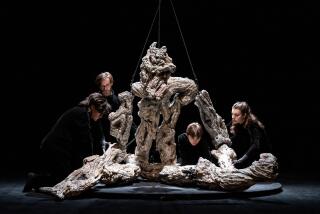MUSIC REVIEW : New ‘Traviata’ in Civic Theatre
SAN DIEGO — Christine Weidinger follows a distinguished line of predecessors--Rosalind Plowright (1984), Diana Soviero (1979), Beverly Sills (1977) and Gilda Cruz-Romo (1970)--in taking on the role of Violetta in Verdi’s “La Traviata,” this week with San Diego Opera.
The soprano from Phoenix--who continues to sing leading roles at major European opera houses as well as in her own country--held her own against whatever memories remain in Civic Theatre from those previous “Traviatas” Saturday night.
Her vocally mid-size, histrionically integrated Violetta may not cause open weeping in the audience, but it can boast telling details and dramatic progression. And it is handsomely sung.
Strong vocalism, indeed, gives this performance a distinction one always hopes for at the opera: healthy sound, the meeting of all technical challenges, musical honesty and a modicum of textual nuance. In all these ways, Weidinger is accomplished.
What the singer, and this particular Violetta, lacks is a base of personal charisma, a self-absorption no stage director or acting coach can give. It is the difference between a creditable and admirable performance, such as Weidinger turns in, and a genuine, deep and memorable characterization.
The same kinds of virtues mark the work of her colleagues, Fernando de la Mora as Alfredo and Richard Stilwell as Germont, pere --who contribute solid but unpenetrating performances.
The tenor from Mexico is a find, the same type of find we heard in this very hall, 25 years ago this spring, when the young Placido Domingo replaced the ailing Mallory Walker as Faust.
De la Mora’s voice is sizable, pure, unforced and beauteous, and his uncomplicated acting carries its own urgency. At this point, neither his musicianship nor his artistry goes deeply into a role, but depth is something that can be added. Talent, his brand of talent, cannot.
Stilwell’s Germont emerges dramatically thorough, though his musicianly singing seldom proves touching. Furthermore, on this stage, and as with Violetta/Alfredo, the Alfredo/Germont relationship remains superficial.
The assisting singing actors, under Wolfgang Weber’s detailed staging scheme, perform ably. They are, among others, David Downing, Patricia Minton Smith, Harlan Foss and Gale Fuller. The chorus, handiwork of Martin Wright, sings lustily, acts credibly.
Despite obvious failures in pit-stage synchronization in both Acts I and II, Edoardo Muller’s leadership from the podium met a high standard for Verdian thrust, dramatic intensity and clear pacing.
The most striking aspect of this “Traviata” became the 1987 San Francisco Opera production. However it appeared in the Bay City, on the Civic Theatre stage it looks made to order and most elegant.
Musically and scenically, the high point of this show happened in the finale to Act III, when, costumed to the hilt--or the neck--in bold, mid-Victorian, whorehouse reds and browns, and occupying John Conklin’s nearly overstated set, the chorus, dancers and principals seemed to overflow the stage while singing that sublime music. For a few minutes, it was a reminder of what opera can be.
Postscript: Another unexpected joy in Act III was Maxine Mahon’s believable Spanish-style choreography for six expert and attractive dancers from California Ballet. As veteran “Traviata”-watchers will recognize, it seldom gets this good.
More to Read
The biggest entertainment stories
Get our big stories about Hollywood, film, television, music, arts, culture and more right in your inbox as soon as they publish.
You may occasionally receive promotional content from the Los Angeles Times.










